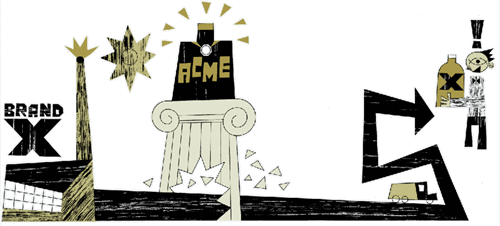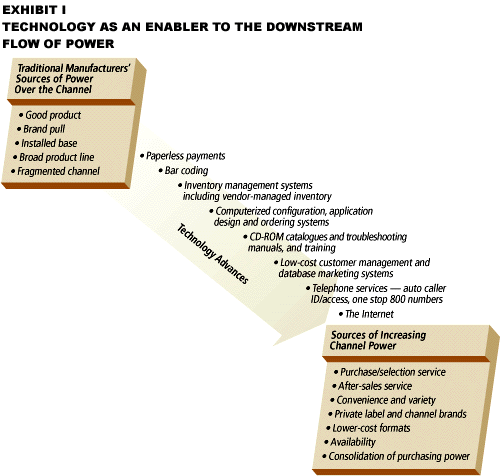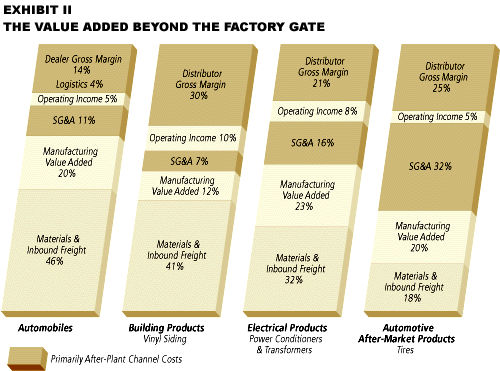Channel Champions: The Rise and Fall of Product-Based Differentiation
Welcome to the new era — where companies are known by their innovative channels, not their commoditized products.
In the beginning there was the product. Centuries ago, craftsmen labored over their products. Such was their devotion that they literally crafted them, piece by piece, inch by inch, to create things of usefulness or beauty, or both. And, in the Industrial Age, whether you were a manufacturer like General Motors or a movie studio like Warner Brothers, products were the basic unit of competitive strength and weakness. Though these companies made more products more efficiently than previously imagined, the fundamental premise was the same: Better or cheaper products attracted more customers; more satisfied customers led to repeat sales and, in turn, to increased profits. Tangible attributes - the touch, appearance, taste and smell of the product - were all. Products were the simple benchmark by which every business was measured. Q.E.D.

Clearly, this is a simplified interpretation of past preoccupations. But it is (with a few glorious exceptions) generally true. Indeed, even now, most manufacturers think primarily of the product when going to market. They think of the most efficient way of making the product. They think of its attributes. They look at it. They touch it. They taste it. They consider how it should be priced. They think of how customers and groups of customers interact with the product. Success or failure is seen as being product related. Get the product right and everything else will fall effortlessly into place.
It is a well-established corporate habit, but being focused on only the product is a dangerous game. Henry Ford may have invented mass production, and he all but invented a mass market for the car, but his blind faith in the Model T nearly pushed his company to self-destruction.
Henry Ford is long gone, and Ford is now refocusing on brands and channels, but his preoccupations live on with other vehicle manufacturers. Products uber alles. One element of the turbulent McDonald's story of recent years has been a continued focus on the product. Ideas such as the Arch Deluxe and the 55-cent Big Mac have largely backfired on the company's United States operations. There is more to McDonald's than its product - as demonstrated by the growth of its Special Points of Distribution in airports and shopping malls, its venture into Mexican food retailing and the growth of the playlands. However, with the support of the franchisees holding ownership in the old channel format, McDonald's focuses on product-dominated marketing campaigns.
Product differentiation can easily become product fascination. History is littered with brilliantly innovative products that few people bought and that are now gathering dust in warehouses. One of the classic examples is Sony's Betamax video system. This was a truly excellent product made by a consistently innovative and imaginative company. Yet, the only place to find a Betamax video is in a museum. The global standard is VHS, which was originated by Matsushita. While Matsushita developed VHS video and licensed the technology, Sony developed the immeasurably better Betamax but failed to license the technology. It assumed its product would be persuasive, but being better was not good enough for Betamax video.
But even if you get it right, in the twilight of the 20th century product-based differentiation is becoming harder to sustain. Product superiority is usually a fleeting illusion. Indeed, the confident commercial assertion of Q.E.D. is rapidly giving way to a more doom-laden prognosis: product differentiation, R.I.P.
COPYING THE ADVANTAGE
The decreasing importance of product-based differentiation as the primary source of competitive advantage can be attributed to two main factors:
1. There is the much-talked-about globalization of competition. No matter what business you are in, life is becoming more competitive. You are faced with having to keep abreast of product developments on a global scale. No matter what your resources, this is virtually impossible. Geographical and physical divides have disappeared. There are fewer barriers to the flow of information. If you improve a product in Beijing, thanks to technology, someone in Baltimore soon will be able to find out - or vice versa. (It is notable that in this new world order, the threat and the opportunity are inextricably linked. Global accessibility is both the opportunity and the source of potential competition.)
2. Rapid technology evolution accelerates the decline in product-based differentiation. Technological change means that products are continually enhanced in order to survive. Product life cycles are perpetually shortening.
These two factors give rise to the third vital factor: rapid imitation of new products and product enhancements. Photographic cameras, for example, have a life span as short as six months. The number of models on the market grows unceasingly as competitors avidly copy one another's innovations. This desperate race with no end makes it clear that products still matter. Of course they do. But having auto focus or the latest gimmick is the price of entry rather than the winning ticket.
The daunting truth is that copying products has never been easier. Any company that protects patents and copyrights is among the surest bets to become a booming business in the new millennium. Goods that are close substitutes for another in the customers' eyes are more generally available than ever before. And we are not talking about street vendors in Malaysia selling pond water masquerading as Chanel or bootleggers in Beijing selling Michael Jackson CD's produced in a backyard. Virtually any product on earth can be speedily replicated.
Products that rely on tangible physical or performance attributes are particularly susceptible to imitation. A Burmese copy of a Black & Decker tool will, in all likelihood, look the same and do the job in the same way. But it will probably not look the same for very long or be able to do the job for much longer than the time it takes for you to leave the country. Street peddlers of watches have followed this strategy for many years. If they say it is a genuine Swiss watch and it looks and feels like a genuine Swiss watch, you may well be convinced. The product is persuasive, because it appears to do the job, even if you know the after-sales service is nonexistent.
It would be easy to assume that product copying is the preserve of the desperate, opportunistic or poor. This is not the case. The world's great corporations are engaged in a constant round of me-too developments. Take a look around.
In financial services, any new product - whether it is an account for the elderly or a more flexible mortgage - is copied almost instantly. There is a constant stream of products and services as old ones are tinkered with, replaced or revamped and entirely new ones are introduced. In one year the British-based bank NatWest introduced 240 new products or improvements to existing products. There is no longer anything particularly unusual in this. Explaining his company's strategy, George A. Schaefer Jr., chief executive of the Cincinnati-based Fifth Third Bancorp, said: "Hustle. That's us. It's what we do. In financial services, where if anyone in town comes out with a new product everyone else has it five seconds later, what really matters is daily execution." (Mr. Schaefer gets to the nub of the argument: Change products all you like, but how and where you deliver them on a daily basis is the real battlefield.)
In industry after industry, bright ideas quickly become permanent fixtures. Today's leading edge is tomorrow's condition of entry. In the car market, anti-lock brakes were heralded as a major step forward. BMW trumpeted its invention. Now, anti-lock brakes are no longer an advantage, and BMW has moved on to "telematics" in a joint venture with Motorola.
Or look at shampoos. Procter & Gamble labored long and hard in developing two-in-one shampoo. After more than a decade spent perfecting the technology, it introduced the product with the usual fanfare. Within two years, most of its competitors had followed suit. Years of investment and a mold-breaking product had provided an advantage that was fleeting. Although P.&G. was ahead of the market with its product, at the time it did not understand well enough how to market beauty-care products. To its credit (and through the acquisition of companies with cosmetic businesses), it quickly learned the lesson.
So, products can provide a competitive advantage. But it is not sustainable for very long - and this period is becoming ever shorter.
This phenomenon is typical of maturing markets and is increasingly common across industries. Nowhere is this more evident than in the personal computer industry. Over two product generations, product-based (or performance-based) differentiation has dramatically declined.
REPERCUSSIONS FOR SUPPLIERS
Clearly, declining product power has implications for how, where and why people buy products. Fundamental assumptions about the supplier- customer relationship are overturned, and there are sizable ripples elsewhere. With product dominance reduced, the balance of power in relationships shifts dramatically. Control of the channel, rather than control of the product, becomes paramount.
For example, think of what happens to suppliers. As product-based differentiation declines, the traditional sources of suppliers' power are weakened. This has three important repercussions:
1. Having a more advanced or more effective product no longer guarantees success. The Apple Macintosh may still be lauded as a ground-breaking product, but Apple is not a successful company. Of course, companies always want to have a better product - look at the attempts by Burger King to displace McDonald's as the french fry leader or Colgate's huge ($100 million) onslaught against Crest. But this is no longer the commercial imperative it once was.
2. Customers are more fickle than ever. They will not automatically come running when they hear a supplier's name. Fever-pitch competition in brands means no one is safe - a point demonstrated by the drama of Marlboro Friday, Diaper Tuesday and the Soap Wars in Europe between Unilever and Procter & Gamble. Even brand giants can no longer automatically call the tune.
3. A large established customer base no longer guarantees future success. As an example, look at how the Coca-Cola Company (with Sprite) and Pepsico Inc. (with Storm) struck into the lemon-lime category. It was a profitable and stable market, long dominated by 7-Up. But it was differentiated from colas and other flavors so that the big players saw it as attractive and entered. The message is that no business is sacrosanct. No business can afford to feel comfortable.
The parameters of any business can change overnight. An apparently secure customer base is an invitation to competitors, not a measure of security. And, to really turn things on their head, companies can actually receive plaudits when they announce that they want to reduce the number of customers they have.
The reality is that power has flowed downstream to the channels in industry after industry. "Category killer" retail formats like Wal-Mart, Home Depot, Best Buy, Car Max, Borders, Tire America, OfficeMax - the list goes on and on - put pressure on suppliers for low costs and high service levels. Traditional sources of power - good products, the pull of a brand, an installed customer base, a broad product line - have diminished in their impact. Added momentum has come from technical advances - everything from bar coding to 800 numbers and, of course, the Internet - that have increased channel power (as Exhibit I demonstrates). Such trends will surely accelerate.

DIFFERENTIATION THROUGH SERVICES
So, how can we break this spiral? If product differentiation is becoming less and less important, what else is there? What lies beyond? As is so often the case, the solution lies within the problem. While product-based differentiation is declining in power, it should not be concluded that differentiation is unimportant. Indeed, differentiation remains the fundamental route to competitive advantage. But the question now is: differentiation of what?
The answer is increasingly that differentiation is achieved as much through the services surrounding the product as through the product itself.
As a result, manufacturers are increasingly turning their attention to the value added - or dissipated - beyond the factory gate. Little wonder. This value can often be as high as 25 percent to 35 percent for many products. (See Exhibit II.) Indeed, 90 percent of the profit potential from the life cycle of a mass-market car does not come from the product.

So, in addition to product differentiation, we have service differentiation. This is based on segmenting customers according to how they want to purchase and interact with the product. The source of differentiation then becomes a combination - or bundle - of products and services. In this model, the channel becomes vital.
In the same way that products are manufactured on a production line, so product or service bundles are delivered by a channel. The channel must add value to the customer. (Remember W. Edwards Deming's observation that "the consumer is the most important part of the production line." The same point applies to channel management.)
A channel can be defined as how and where a product (or service) is purchased and how and where the product is used. It is the essence of how customers and the product interact. It is the route to the customer and the ongoing relationship with the customer.
Good channel management has, as a result, become much more than just a basic necessity of doing business: It now has the potential to differentiate one manufacturer from another. Channels and the bundle of services they bring with them are a crucial differentiating force. How the channels are managed is a critical lever in improving business performance. This is what a growing number of successful companies are realizing. We call them channel champions, and they are leading the way.
CHANNEL CHAMPIONS
The range of companies utilizing effective channel management and benefiting from it, as well as the wide-ranging nature of their businesses, makes it clear that channels are a fact of business life across all sectors and industries. Channels are as relevant to a car manufacturer as to a retail chain, as important to a bank as to a dishwasher maker.
Look at what has happened at Levi Strauss. The product has remained much the same over the decades. What has changed is how Levi manages and perceives the channels through which it sells its products. "We are appealing to a broad range of consumers for different wearing occasions in casual wear, and as long as they feel that our products fulfill their psychological needs as well as the product requirements, we've made our mark," the company's chief executive, Robert Haas, said. In a paragraph, Mr. Haas pithily redefined the business for the new millennium. The channel - the psychological experience - is the thing as well as the physical satisfaction of the product. "We are in the comfort business, and I don't just mean physical comfort. I mean we are providing psychological comfort - the feeling of security that when you enter a room of strangers or even work colleagues, you are attired within the band of acceptability. Although obviously what a consumer defines as psychological comfort may vary from subsegment to subsegment," Mr. Haas said. The new challenge lies in learning about the psychology of real and potential customers, identifying segment after segment. (This does not guarantee success if your product is increasingly out of step with the marketplace - something Levi Strauss discovered to its eventual cost.)
No matter whether you run a pet- food store, make tires or sell second-hand autos, opening up new channels through which customers can interact with your product is perhaps the most potent means of bringing your business to life.
 The need for channel management crosses all divides. Think of a museum. If there is a museum in your town, you will probably pay it a visit at some time. You will then consider that the matter is closed. You have assuaged your civic interest. Part of the job of the museum, however - to maintain or increase the number of visitors and members - should be to give people repeated opportunities to interact with it. It could do so in a myriad of ways: promoting school visits, changing exhibitions, involving people in archaeological digs, allowing people behind the scenes, taking exhibits on the road, creating educational puzzles and games. Greater interaction gives people the opportunity to become more and more involved. Experiencing the same product in different ways allows it to remain fresh - and there are many ways of retaining freshness.
The need for channel management crosses all divides. Think of a museum. If there is a museum in your town, you will probably pay it a visit at some time. You will then consider that the matter is closed. You have assuaged your civic interest. Part of the job of the museum, however - to maintain or increase the number of visitors and members - should be to give people repeated opportunities to interact with it. It could do so in a myriad of ways: promoting school visits, changing exhibitions, involving people in archaeological digs, allowing people behind the scenes, taking exhibits on the road, creating educational puzzles and games. Greater interaction gives people the opportunity to become more and more involved. Experiencing the same product in different ways allows it to remain fresh - and there are many ways of retaining freshness.
The logic is inexorable. Across many industries, advancing levels of competition are resulting in increased power for channels. One thing leads to another. There is, as we have discussed, greater availability of close substitutes for basic product values. Competing products can do the job, look the part and are made well. Manufacturer-driven values are no longer a sure route to competitive strength. The reality is that quality levels in product manufacturing have improved. At the same time, companies are experiencing more difficulty in innovating distinctive new products, driven by diminishing product life cycles and faster competitor responses to new product developments.
This leads to more customer choice and attempts to address the needs of more focused customer segments - indeed, segments of one. An ever-more-intimate knowledge of consumers increases the push toward non-product differentiation. Issues such as convenience, availability, purchase and ownership experiences, and after-sales service become increasingly important. This inevitably results in differentiation and power flowing downstream into the channels and to end customers.
It is no longer just the product that counts, but how, when and where it is delivered to the customer.
WE ARE THE CHAMPIONSAs channels evolve to serve changing or finer customer demands, existing players lose ground or respond as new winners emerge. Dell comes to mind, of course, but think also of Gateway, which is now moving into selling computing rather than PC's. They are not alone. Channel champions are emerging across a broad range of industries:
Genuine Parts in the automotive aftermarket. Genuine Parts helped transform the auto parts after-market wholesale distribution industry. Before its arrival, the industry was highly fragmented with separate warehouse distributor and jobber structures. Genuine Parts, with 63 United States distribution centers supplying 5,200 "associate" jobbers, brings a high-scale, uniform, efficient warehouse operation; a sophisticated inventory management; an electronic interface with suppliers, jobbers and installers, and an extensive support for jobbers. The result? Significantly lower logistics costs; superior fill rates; reduced selling costs; increased purchasing leverage with suppliers; a wider product offering; a double-digit operating margin, and the expansion of automotive business sales from $1.5 billion in 1985 to $6 billion in 1997.
United Stationers in office supplies. United Stationers grew from sales of $170 million in 1980 to become a $1.5 billion industry leader in 1992 with a 50 percent share of the market. Now, it has sales of $3 billion. It virtually eliminated small, independent distributors (though it is now under pressure from low-cost cash-and-carry office product warehouses). United Stationers' achievement was to restructure the office supply distribution industry totally. Before the company acted, it had an extremely fragmented distribution base. It introduced a well-managed product catalogue and developed a distribution center network.
Lexus in automobiles. Forget the impressive statistics - the Lexus took seven years; $2 billion; 1,400 engineers; 2,300 technicians, and 450 prototypes; and it generated 200 patents - and feel the service. Good car, fantastic, differentiating service - sales were up 40 percent in 1998 from a year earlier.
 Autonation in transportation. Autonation is shaking up the car retailing industry, causing a wave of reactions from vehicle manufacturers. At the end of 1998 it owned more than 65 dealer groups in the United States with more than 335 franchises. With total sales exceeding $17 billion, it is more than four times larger than the next largest dealer group, VT Inc. It also has a chain of 25 used-car superstores. Since 1996, Autonation has doubled automotive retail revenues annually. It is now pushing to build its own brand name (Autonation USA), having started with a major pilot test in the Denver market, and is aggressively expanding its Internet presence.
Autonation in transportation. Autonation is shaking up the car retailing industry, causing a wave of reactions from vehicle manufacturers. At the end of 1998 it owned more than 65 dealer groups in the United States with more than 335 franchises. With total sales exceeding $17 billion, it is more than four times larger than the next largest dealer group, VT Inc. It also has a chain of 25 used-car superstores. Since 1996, Autonation has doubled automotive retail revenues annually. It is now pushing to build its own brand name (Autonation USA), having started with a major pilot test in the Denver market, and is aggressively expanding its Internet presence.
Saturn in automobiles. With the creation of Saturn, General Motors realized that car buyers were fed up with buying from car salespeople and with the poor service of most dealerships. Saturn created its own dealer network and, as a result, increased repeat purchases and customer satisfaction dramatically. Rather than viewing the car narrowly as a product, the new approach recognized that customers wanted a bundle of transportation services. Saturn's brand development focused on the buying experience, service and support, rather than being narrowly focused on the product. It was concerned with people and processes rather than the product.
Daewoo has gone one step further, cutting out the dealer network altogether. In effect, Daewoo is doing to autos what Dell has already done to PC's. It is experimenting in the United States and Britain with nontraditional ways of selling vehicles.
The Home Depot in building products. With 27 consecutive quarters of record sales and record earnings, Home Depot's stock price has increased at a compound annual rate of more than 70 percent for the last eight years. Every year 40 to 50 new stores are being added, as Home Depot expands into new geographic markets such as the Northeast United States, as well as California and Florida. Along the way, Home Depot has revolutionized the do-it-yourself market with innovative channel management. Its annual sales now top $24 billion.
W.W. Grainger in general industrial products. Grainger provides one-stop convenience shopping to industrial accounts and general contractors. Its 332 branches with retail-style counter sales have a broad product offering backed by a widely distributed catalogue (now available on CD-ROM) and extensive advertising. It boasts gross margins of 35 or 36 percent against the electrical wholesaler average of 26 or 27 percent. It is now making a major foray into electronic commerce.
Wal-Mart in mass merchandising. Wal-Mart recognized that many consumers want to buy affordably and get good service and name brands, so it forged partnerships with product companies like Procter & Gamble for direct purchase, stocking and inventory management. The result: huge and profitable growth on the traditionally low-margin mass merchandise market.
General Electric in appliances. G.E. Appliances sells more than 10 million appliances in 150 world markets, including refrigerators, freezers, ranges, cooktops, wall ovens, dishwashers and washing machines. Its brands include Monogram, G.E. Profile, Hotpoint and RCA. Its achievement has been to keep one channel - the small mom and pop store - alive and viable in the face of competition from Circuit City and the like, by offering superior logistics, after-sales service and end-customer service.
Providian Bancorp in financial services. Providian has built up a credit portfolio of more than $5 billion in only 10 years, thanks to understanding its customers in ways never previously thought of and giving them exactly what they want. Providian can provide consumer credit on a one-to-one basis, so each customer has his or her own interest rate and repayment terms. Responsive yet proactive, Providian has reshaped financial services marketing and branding.
Snap-on Tools in tool supply. For years Snap-on has bypassed the usual distribution channels to sell directly to its customers (garages and auto dealerships) via fleets of self-managed dealers on wheels. It sells high-quality tools at premium prices and cuts out the competition by going to where its customers work. It is now entering a new channel by supplying private-label tools to Lowe's, a leading United States retailer. ![]()
Reprint No. 99406

